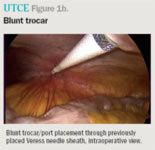Article
Laparoscopic ports: Bladed or not?
Conflicting data on fascial defect size and port fixity render any perception of surgical advantage per port type as theoretical. Thus, regarding this aspect, the decision to use bladed or non-bladed trocars is likely best left to surgeon preference.

Key Points


More than 80% of these complications are due to primary trocar placement,2 with 83% of vascular injuries and 75% of bowel injuries occurring during this step.4 Thus, a significant amount of research and development has been directed toward both entry technique and trocar type resulting in numerous device designs, including bladed and non-bladed trocars. In this article, we discuss the three primary techniques for obtaining laparoscopic access, clinical aspects of bladed versus non-bladed ports, and our preferred technique based on experience from more than 800 laparoscopic cases.
Generally, there are three techniques for primary trocar placement:


Newsletter
Stay current with the latest urology news and practice-changing insights — sign up now for the essential updates every urologist needs.
















